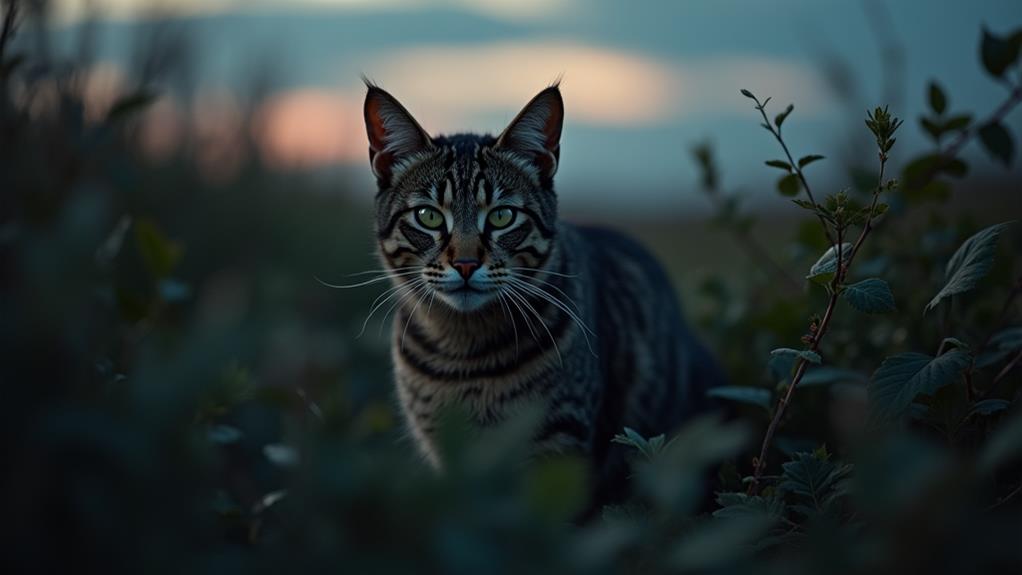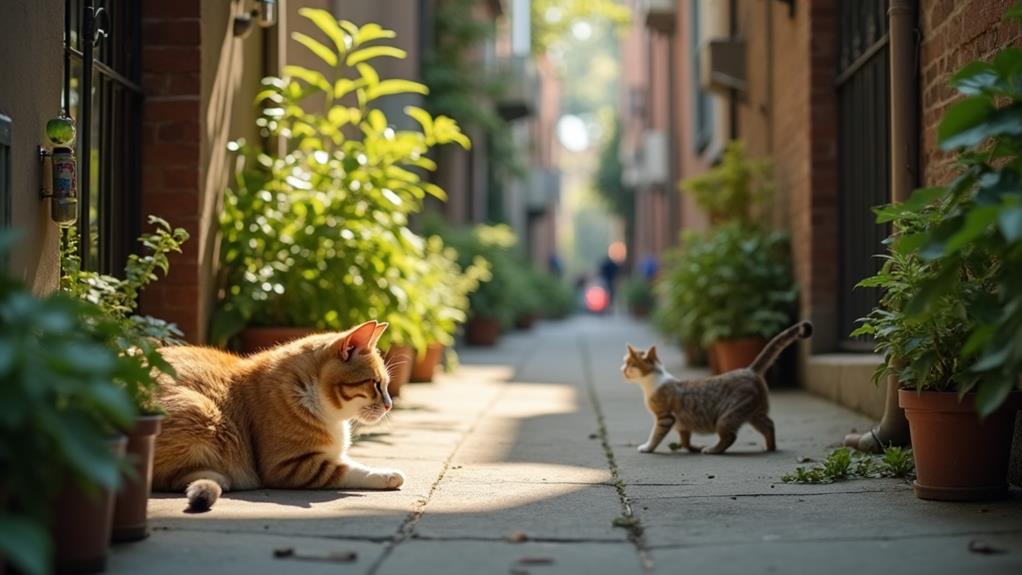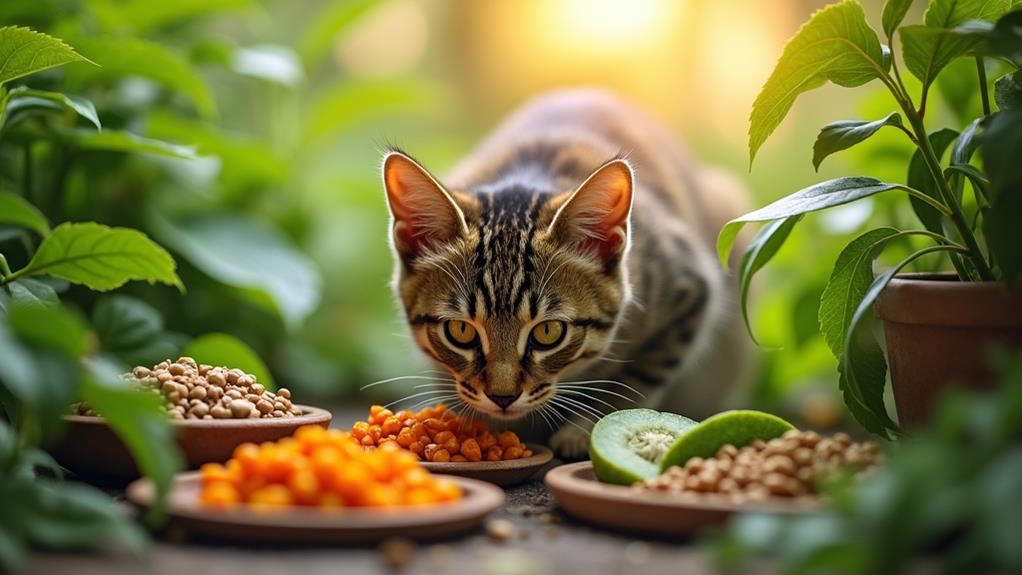How Long Does a Feral Cat Live? Average Lifespan and Factors

Feral cats typically live around 2 to 5 years, much less than their domesticated relatives, due to the harsh and unpredictable environments they face. They're constantly challenged by predators, traffic, extreme weather, and lack of access to regular food and veterinary care. However, factors like managed colonies, neutering, and consistent feeding programs can greatly extend their lifespans, sometimes up to 10 years or more. By stabilizing their environments and providing crucial care, these interventions improve their chances. There's more to learn about how different approaches can improve their lifespan and welfare.
Understanding Feral Cats
When you encounter feral cats, it is crucial to understand that they are not simply stray or lost pets. Feral cats live in a state that requires them to fend for themselves, often without the human interaction that domestic cats rely on. This independence comes with its challenges, particularly regarding their welfare and survival. The Average Lifespan of these cats is considerably shorter than that of their domesticated counterparts, often ranging from 2 to 5 years. This stark difference is largely due to the lack of consistent shelter, food, and medical care.
Adult cats in feral colonies face daily challenges that threaten their survival, including harsh weather conditions, predators, and human-related dangers. Feral kittens are particularly vulnerable, with nearly half not surviving past their initial year. This high mortality rate drastically impacts the overall lifespan statistics for feral populations. Ensuring feral cat welfare involves understanding their needs and supporting managed colonies, where community efforts provide food, shelter, and veterinary care. By doing so, you can help extend the lives of feral cats, promoting a healthier environment for both adult cats and feral kittens.
Average Lifespan of Feral Cats
Feral cats generally lead much shorter lives than their domestic counterparts, with an average lifespan ranging from 2 to 5 years. This is mainly due to the harsh living conditions they face and the lack of medical care. However, feral cats that are part of managed colonies, where they receive regular feeding, shelter, and veterinary attention, can live considerably longer, sometimes reaching 7 to 10 years or more.
Consider the following:
- Harsh Weather: Exposure to extreme temperatures can drastically reduce a feral cat's life expectancy.
- Lack of Food: Without consistent access to food, feral cats often suffer from malnutrition.
- High Mortality Rate: The mortality rate for feral kittens is alarmingly high, with around 75% not surviving their initial six months.
- Disease and Fighting: Unsterilized cats frequently face injuries from fights and are prone to diseases, further shortening their lives.
- Shelter Availability: Access to safe shelter can mean the difference between life and death, especially in harsh weather.
Unsterilized feral cats, in particular, often live only around 2 years. The high mortality rate among kittens, coupled with environmental challenges, underscores the importance of managed colonies to improve their average lifespan and general quality of life.
Factors Affecting Lifespan

Life in the wild presents numerous challenges that dramatically affect the lifespan of feral cats. They're faced with harsh conditions—lack of food, exposure to diseases, and no shelter—leading to an average lifespan of just 2 to 5 years. In contrast, indoor cats enjoy a safe environment and can live 10 to 15 years on average.
Environmental factors play a considerable role in the mortality rates of feral cats. Extreme weather conditions, predators, and human-related dangers are constant threats. Without consistent access to food and shelter, feral cats struggle to survive, which profoundly impacts their lifespan. However, managed colonies offer a glimmer of hope. By providing regular feeding, veterinary care, and shelter, these colonies can greatly extend a feral cat's lifespan to 7 to 10 years or more.
Neutering is another vital factor that can positively influence their lifespan. By reducing aggressive behaviors and minimizing health risks associated with breeding, neutering can help feral cats live longer, often reaching 6 years or more. It's clear that intervention through managed colonies and neutering can make a significant difference in giving feral cats a healthier, longer life.
Indoor vs. Outdoor Risks
Indoor cats generally lead longer, healthier lives compared to their outdoor counterparts due to fewer risks and consistent care. While indoor cats can enjoy an average lifespan of 10 to 15 years, feral cats, living outdoors without regular human interaction, typically only reach 2 to 5 years. The lifespan of a feral cat is greatly impacted by outdoor living's harsh realities. Free-roaming cats face numerous hazards that contribute to their shorter lifespans.
Consider these risks for feral cats:
- Traffic Accidents: Constantly dodging vehicles is a daily danger, leading to many untimely fatalities.
- Predation: Larger animals pose a constant threat, making survival even more challenging.
- Starvation: With unpredictable food sources, malnutrition is a common struggle.
- Disease: Lack of veterinary care leads to untreated illnesses, drastically reducing lifespans.
- Weather Extremes: Harsh conditions, from freezing winters to scorching summers, leave them vulnerable.
On the other hand, indoor cats benefit from regular veterinary visits, balanced diets, and protection from these threats, enhancing their general well-being. Free-roaming cats, lacking such privileges, face high mortality rates, especially among kittens, with nearly half not surviving their initial year. This stark contrast highlights the impact of environment on a cat's longevity.
Impact of Neutering

While outdoor risks undeniably shorten the lifespan of free-roaming cats, addressing these challenges can make a difference. Neutering plays a vital role in improving the lifespan and health of feral cats. By participating in Trap-Neuter-Return (TNR) programs, you can greatly extend a feral cat's life. Neutered feral cats often live six years or more, compared to the mere two-year average for their un-neutered counterparts.
Spaying and neutering help reduce aggressive behaviors in male feral cats. This leads to fewer fights and, consequently, a lower rate of injuries. Such improvements in health contribute positively to their total longevity. For female feral cats, being spayed means they don't experience heat cycles. This reduction in stress and the prevention of unwanted pregnancies help stabilize the colony population, further supporting their well-being.
TNR programs, which focus on neutering feral cats, have shown impressive results. Studies suggest that neutering aligns the lifespans of feral cats with those of spayed female house cats. Essentially, these programs promote healthier and longer-lived feral cat populations. By supporting neutering efforts, you're directly enhancing the lives of these resilient creatures.
Role of Managed Colonies
Managed feral cat colonies are fundamental for extending the lifespan of these animals. In these colonies, cats often live six years or more, considerably longer than the average two years for unsterilized feral cats. You can make a real difference by participating in efforts that support these colonies. With your help, caretakers provide crucial resources like food, water, and shelter. This care not only improves their quality of life but also addresses potential health issues before they become severe.
The Trap-Neuter-Return (TNR) program plays a pivotal role in managed colonies by stabilizing populations and preventing the birth of unwanted kittens. This approach reduces competition for resources and promotes better health outcomes.
Imagine the impact of your involvement:
- A safe haven: Reduced risk from traffic and predators.
- Full bellies: Access to regular cat food and clean water.
- Healthy lives: Regular veterinary visits to catch health issues early.
- Stable numbers: Fewer unwanted kittens born, reducing stress on the colony.
- Community support: A group of caring individuals working together.
Nutrition and Health Needs

A feral cat's well-being hinges considerably on its nutrition and health needs. Ensuring that feral cats receive a balanced diet is vital for their health and longevity. Without proper nutrition, these cats often face a shortened lifespan, typically ranging from 2 to 5 years. You can help by providing regular feeding with safe, high-quality cat food. Avoid giving them onions or grapes, as these are toxic. Access to fresh water is just as significant, especially to prevent dehydration, which is a real threat in winter conditions.
Regular feeding programs can make a world of difference. By consistently providing food, you help stabilize their health, giving them a fighting chance to live up to 7-10 years or more. Alongside nutrition, veterinary care plays a key role. Sterilization and vaccination are vital steps in improving their health. These measures reduce common issues like upper respiratory infections and flea infestations, enhancing their general quality of life.
Environmental Challenges and Solutions
Feral cats face numerous environmental challenges that can drastically shorten their lifespan. They struggle with harsh weather, lacking adequate shelter to protect them from extreme temperatures. This can be a matter of life or death, especially in severe cold or heat. Without proper protection, their average lifespan drops dramatically to around 2 to 5 years. However, you can prolong their longevity by addressing these environmental hurdles.
- Harsh weather conditions: Extreme cold or heat can lead to hypothermia or heatstroke.
- Lack of shelter: Without a safe place to retreat, cats are vulnerable to the elements.
- Scarcity of fresh water: Dehydration poses a considerable threat, especially during extreme weather.
- Traffic hazards: Busy roads increase the risk of accidents.
- Predation risks: Lack of safe green spaces leaves cats exposed to predators.
To mitigate these challenges, consider providing insulated shelters equipped with straw and heating pads. This simple solution can greatly improve their chances of surviving cold weather. Furthermore, make certain they have consistent access to fresh water to prevent dehydration. By creating a safer environment and minimizing these environmental challenges, you can improve the feral cats' quality of life and potentially extend their lifespan well beyond the average.




